Application of Rough and Fuzzy Set Theory for Prediction of Stochastic Wind Speed Data Using Long Short-Term Memory
Abstract
:1. Introduction
2. Materials and Methods
2.1. Dataset
Wind Characteristics
2.2. Rough Set Theory (RST)
2.3. Interval Type-2 Fuzzy Sets
2.4. Long Short-Term Memory (LSTM) Network
2.5. Evaluation Criteria
3. Results and Discussion
3.1. Selection of Input Variable
3.2. Wind Speed Forecasting Models
4. Conclusions
Author Contributions
Funding
Institutional Review Board Statement
Informed Consent Statement
Data Availability Statement
Conflicts of Interest
References
- Oyedepo, S.O.; Adaramola, M.S.; Paul, S.S. Analysis of wind speed data and wind energy potential in three selected locations in south-east Nigeria. Int. J. Energy Environ. Eng. 2012, 3, 7. [Google Scholar] [CrossRef] [Green Version]
- Foley, A.M.; Leahy, P.G.; Marvuglia, A.; McKeogh, E.J. Current methods and advances in forecasting of wind power generation. Renew. Energy. 2012, 37, 1–8. [Google Scholar] [CrossRef] [Green Version]
- Chen, J.; Zeng, G.Q.; Zhou, W.; Du, W.; Lu, K.D. Wind speed forecasting using nonlinear-learning ensemble of deep learning time series prediction and extremal optimization. Energy Convers. Manag. 2018, 165, 681–695. [Google Scholar] [CrossRef]
- Cassola, F.; Burlando, M. Wind speed and wind energy forecast through Kalman filtering of Numerical Weather Prediction model output. Appl. Energy. 2012, 99, 154–166. [Google Scholar] [CrossRef]
- Chen, L.; Li, Z.; Zhang, Y. Multiperiod-Ahead Wind Speed Forecasting Using Deep Neural Architecture and Ensemble Learning. Math. Probl. Eng. 2019, 9240317. [Google Scholar] [CrossRef]
- Jung, J.; Broadwater, R.P. Current status and future advances for wind speed and power forecasting . Renew. Sustain. Energy Rev. 2014, 31, 762–777. [Google Scholar] [CrossRef]
- Khodayar, M.; Wang, J. Spatio-Temporal Graph Deep Neural Network for Short-Term Wind Speed Forecasting. IEEE Trans. Sustain. Energy 2019, 10, 670–681. [Google Scholar] [CrossRef]
- Wang, H.; Liu, D.; Wang, J.L. Ultra-Short-Term Wind Speed Prediction Based on Spectral Clustering and Optimized Extreme Learning Machine. Power Syst. Technol. 2015, 5, 1307–1314. [Google Scholar]
- Zeng, J.; Zhang, H. A Wind Speed Forecasting Model Based on Least Squares Support Vector Machine. Power Syst. Technol. 2009, 18, 144–147. [Google Scholar]
- Tascikaraoglu, A.; Uzunoglu, M. A review of combined approaches for prediction of short-term wind speed and power. Renew. Sustain. Energy Rev. 2014, 34, 243–254. [Google Scholar] [CrossRef]
- Twain, M. Wind Power Forecasting. In Valuing Wind Generation on Integrated Power Systems; Elsevier Inc.: Amsterdam, The Netherlands, 2010; pp. 87–99. [Google Scholar]
- Chang, G.; Lu, H.; Chang, Y.; Lee, Y. An improved neural network-based approach for short-term wind speed and power forecast. Renew. Energy 2017, 105, 301–311. [Google Scholar] [CrossRef]
- Noorollahi, Y.; Jokar, M.A.; Kalhor, A. Using artificial neural networks for temporal and spatial wind speed forecasting in Iran. Energy Convers. Manag. 2016, 115, 17–25. [Google Scholar] [CrossRef]
- Imani, M.; You, R.J.; Kuo, C.Y. Caspian Sea level prediction using satellite altimetry by artificial neural networks. Int. J. Environ. Sci. Technol. 2014, 11, 1035–1042. [Google Scholar] [CrossRef] [Green Version]
- Wang, H.; Li, G.; Wang, G.; Peng, J.; Jiang, H.; Liu, Y. Deep learning based ensemble approach for probabilistic wind power forecasting. Appl. Energy 2017, 188, 56–70. [Google Scholar] [CrossRef]
- Qureshi, A.S.; Khan, A.; Zameer, A.; Usman, A. Wind power prediction using deep neural network based meta regression and transfer learning. Appl. Soft Comput. 2017, 58, 742–755. [Google Scholar] [CrossRef]
- Lv, Y.; Duan, Y.; Kang, W.; Li, Z.; Wang, F. Traffic flow prediction with big data: A deep learning approach. IEEE Trans. Intell. Transp. Syst. 2014, 16, 865–873. [Google Scholar] [CrossRef]
- Qiu, X.; Ren, Y.; Suganthan, P.N.; Amaratunga, G. Empirical mode decomposition based ensemble deep learning for load demand time series forecasting. Appl. Soft Comput. 2017, 54, 246–255. [Google Scholar] [CrossRef]
- Hu, Q.; Zhang, R.; Zhou, Y. Transfer learning for short-term wind speed prediction with deep neural networks. Renew. Energy 2016, 85, 83–95. [Google Scholar] [CrossRef]
- Wang, H.; Wang, G.; Li, G.; Peng, J.; Liu, Y. Deep belief network based deterministic and probabilistic wind speed forecasting approach. Appl. Energy 2016, 182, 80–93. [Google Scholar] [CrossRef]
- Li, R.; Hu, Y.; Liang, Q. T2F-LSTM Method for Long-term Traffic Volume Prediction. IEEE Trans Fuzzy Syst. 2020, 28, 3256–3264. [Google Scholar] [CrossRef]
- Huang, Y.; Zhao, H.; Huang, X. A Prediction Scheme for Daily Maximum and Minimum Temperature Forecasts Using Recurrent Neural Network and Rough set. IOP Conf. Ser. Earth Environ. Sci. 2019, 237, 022005. [Google Scholar] [CrossRef]
- Ma, X.L.; Tao, Z.M.; Wang, Y.H. Long short-term memory neural network for traffic speed prediction using remote microwave sensor data. Transp. Res. Part C Emerg. Technol. 2015, 54, 187–197. [Google Scholar] [CrossRef]
- Liu, Y.P.; Zheng, H.F.; Feng, X.X. Short-term traffic flow prediction with Conv-LSTM. In Proceedings of the International Conference on Wireless Communications & Signal Processing, Nanjing, China, 11–13 October 2017; pp. 1–6. [Google Scholar]
- Yang, B.B.; Yin, K.L.; Du, J. Dynamic prediction model of landslide displacement based on time series and long and short time memory networks. Chin. J. Rock Mech. Eng. 2018, 37, 2334–2343. [Google Scholar]
- Liu, Y.X.; Fan, Q.X.; Shang, Y.Z.; Fan, Q.M.; Liu, Z.W. Short-term water level prediction method for hydropower stations based on LSTM neural network. Adv. Sci. Technol. Water Resour. 2019, 39, 56–60. [Google Scholar]
- Beaubouef, T.; Petry, F.E. Fuzzy and Rough Set Approaches for Uncertainty in Spatial Data. In Studies in Fuzziness and Soft Computing; Jeansoulin, R., Ed.; Springer-Verlag: Berlin/Heidelberg, Germany, 2010; Volume 256, pp. 103–129. [Google Scholar]
- Mostafaeipour, A.; Mostafaeipour, N. Renewable energy issues and electricity production in Middle East compared with Iran. Renew. Sust. Energ. Rev. 2009, 13, 1641–1645. [Google Scholar] [CrossRef]
- Shabaniverki, M.; Shabaniverki, H.; Babapoor, H.; Banisaffar, M. An Overview of Wind and Solar Energies in Iran. In Proceedings of the 1st Technical Seminar on the Role of New Technologies in Protecting Environment Faculty of New Sciences & Technologies, University of Tehran, Tehran, Iran, 17 February 2015. [Google Scholar]
- Hadipour, V.; Vafaie, F.; Lan, W.H.; Kerle, N. An indicator-based approach to assess social vulnerability of coastal areas to sea-level rise and flooding: A case study of Bandar Abbas city, Iran. Ocean Coast Manag. 2020, 188, 105077. [Google Scholar] [CrossRef]
- Renewable Energy and Energy Efficiency Organization. Available online: http://www.satba.gov.ir/en/home (accessed on 28 February 2021).
- Zhu, M.; Atkinson, B.W. Observed and modelled climatology of the land–sea breeze circulation over the Persian Gulf. Int. J. Climatol. 2004, 24, 883–905. [Google Scholar] [CrossRef]
- Pawlak, Z. Rough sets. Int. J. Comput. Inf. Sci. 1982, 11, 341–346. [Google Scholar] [CrossRef]
- Wang, S.; Wang, W.; Sun, W.; Zhang, K. Short-Term Load Forecasting of Micro Grid Based on Rough Sets and BP Neural Network. Control Eng. China 2018, 25, 1528–1533. [Google Scholar]
- Chen, S.; Wu, A.; Wang, Y.; Chen, X. Rock Mass Quality Evaluation Based on Rough Set and Improved Efficacy Coefficient Method. J. Huazhong Uni. Sci. Technol. 2018, 46, 36–41. [Google Scholar]
- Durairaj, M.; Meena, K. A Hybrid Prediction System Using Rough Sets and Artificial Neural Networks. IJITEE 2011, 1, 16–23. [Google Scholar]
- Stefanowski, J. On rough set based approaches to induction of decision rules. Rough Sets Knowl. Discov. 1998, 1, 500–529. [Google Scholar]
- Niu, D.; Ji, L.; Ma, Q.; Li, W. Knowledge Mining Based on Environmental Simulation Applied to Wind Farm Power Forecasting. Math. Probl. Eng. 2013, 597562. [Google Scholar] [CrossRef] [Green Version]
- Zadeh, L. The concept of a linguistic variable and its application to approximate reason-1. Inf. Sci. 1975, 8, 199–249. [Google Scholar] [CrossRef]
- Mizumoto, M.; Tanaka, K. Some properties of fuzzy sets of type-2. Inf. Control 1976, 31, 312–340. [Google Scholar] [CrossRef] [Green Version]
- Pawlak, Z. Rough Sets; University of Information Technology and Management ul: Warsaw, Poland, 1982; p. 51. [Google Scholar]
- Li, Y.M.; Huang, J. Type-2 fuzzy mathematical modeling and analysis of the dynamical behaviors of complex ecosystems. Simul. Model. Pract. Th. 2008, 16, 1379–1391. [Google Scholar]
- Li, R.M.; Jiang, C.Y.; Zhu, F.H. Traffic flow data forecasting based on Interval Type-2 Fuzzy Sets theory. J. Auto. Sinica 2016, 2, 141–148. [Google Scholar]
- Zhao, H.; Wang, P.; Hu, Q.H. Fuzzy rough set based feature selection for large-scale hierarchical classification. IEEE Trans Fuzzy Syst. 2018, 27, 1891–1903. [Google Scholar] [CrossRef]
- Greenfield, S.; Chiclana, F. Defuzzification of the discretized generalized type-2 fuzzy set: Experimental evaluation. Inf. Sci. 2013, 244, 1–25. [Google Scholar] [CrossRef] [Green Version]
- Eierdanz, F.; Alcamo, J.; Acosta-Michlik, L.; Krömker, D.; Tänzler, D. Using fuzzy set theory to address the uncertainty of susceptibility to drought. Reg. Environ. Chang. 2008, 8, 197–205. [Google Scholar] [CrossRef]
- Wu, D.; Mendel, J.M. Uncertainty measures for interval type-2 fuzzy sets. Inf. Sci. 2007, 177, 5378–5393. [Google Scholar] [CrossRef]
- Castillo, O.; Melin, P. Type-2 Fuzzy Logic: Theory and Applications. Stud. Fuzziness Soft Comput. 2008, 223. [Google Scholar] [CrossRef]
- Mendel, J.M. Uncertain Rule-Based Fuzzy Logic Systems: Introduction and New Directions. PrenticeHall PTR 2001. [Google Scholar] [CrossRef]
- Castillo, O. Type-2 Fuzzy Logic in Intelligent Control Applications. Stud. Fuzziness Soft Comput. 2012, 272. [Google Scholar] [CrossRef]
- Mendel, J.M. Uncertain Rule-Based Fuzzy Systems. Introduction and New Directions, 2nd ed.; Springer International Publishing AG: Basel, Switzerland, 2017. [Google Scholar]
- Hochreiter, S.; Schmidhuber, J. Long short-term memory. Neural Comput. 1997, 9, 1735–1780. [Google Scholar] [CrossRef] [PubMed]
- Abigogun, O.A. Data Mining, Fraud Detection and Mobile Telecommunications: Call Pattern Analysis with Unsupervised Neural Networks. Master’s Thesis, University of the Western Cape, Greater Cape Town, South Africa, 2005. [Google Scholar]
- Liu, Y.; Guan, L.; Hou, C.; Han, H.; Liu, Z.; Sun, Y.; Zheng, M. Wind Power Short-Term Prediction Based on LSTM and Discrete Wavelet Transform. Appl. Sci. 2019, 9, 1108. [Google Scholar] [CrossRef] [Green Version]
- Hu, Q.; Su, P.; Yu, D.; Liu, J. Pattern-based wind speed prediction based on generalized principal component analysis. IEEE Trans. Sustain. Energy 2014, 5, 866–874. [Google Scholar] [CrossRef]
- Imani, M.; Kao, H.C.; Lan, W.H.; Kuo, C.Y. Daily sea level prediction at Chiayi coast, Taiwan using extreme learning machine and relevance vector machine. Glob. Planet. Chang. 2018, 161, 211–221. [Google Scholar] [CrossRef]
- Steuer, R.; Kurths., J.; Daub., C.; Weise, J.; Selbig, J. The mutual information: Detecting and evaluating dependencies between variables. Bioinformatics 2020, 18, S231–S240. [Google Scholar] [CrossRef] [PubMed] [Green Version]
- May, R.; Dandy, G.; Maier, H. Review of Input Variable Selection Methods for Artificial Neural Networks. In Artificial Neural Networks—Methodological Advances and Biomedical Applications; Suzuki, K., Ed.; BoD—Books on Demand: Norderstedt, Germany, 2011; p. 362. [Google Scholar]
- Vergara, J.R.; Estévez, P.A. A review of feature selection methods based on mutual information. Neural Comput. Appl. 2014, 24, 175–186. [Google Scholar] [CrossRef]
- Battiti, R. Using mutual information for selecting features in supervised neural net learning. IEEE Trans Neural Netw. 1994, 5, 537–550. [Google Scholar] [CrossRef] [PubMed] [Green Version]
- Rashidi Khazaee, P.; Mozayani, N.; Jahed Motlagh, M.R. Mutual Information Based Input Variable Selection Algorithm and Wavelet Neural Network for Time Series Prediction. In Proceedings of the International Conference on Artificial Neural Networks, Berlin/Heidelberg, Germany, 15–18 September 2008. [Google Scholar]
- Rossi, F.; Lendasse, A.; Francois, D.; Wertz, V.; Verleysen, M. Mutual Information for the selection of relevant variables in spectrometric nonlinear modelling. Chemometr. Intell. Lab. 2006, 80, 215–226. [Google Scholar] [CrossRef] [Green Version]
- Darudi, A.; Rezaeifar, S.; Javidi Dasht Bayaz, M.H. Partial Mutual Information Based Algorithm for Input Variable Selection. In Proceedings of the 13th International Conference on Environment and Electrical Engineering (EEEIC), Wroclaw, Poland, 1–3 November 2013. [Google Scholar]
- Khodayar, M.; Kaynak, O.; Khodayar, M.E. Rough Deep Neural Architecture for Short-Term Wind Speed Forecasting. IEEE Trans. Ind. Inform. 2017, 13, 2770–2779. [Google Scholar] [CrossRef]
- Qu, X.; Yang, J.; Chang, M. A Deep Learning Model for Concrete Dam Deformation Prediction Based on RS-LSTM. J. Sens. 2019, 4581672. [Google Scholar] [CrossRef]
- Skowron, A.; Dutta, S. Rough sets: Past, present, and future. Nat Comput. 2018, 17, 855–876. [Google Scholar] [CrossRef] [PubMed] [Green Version]
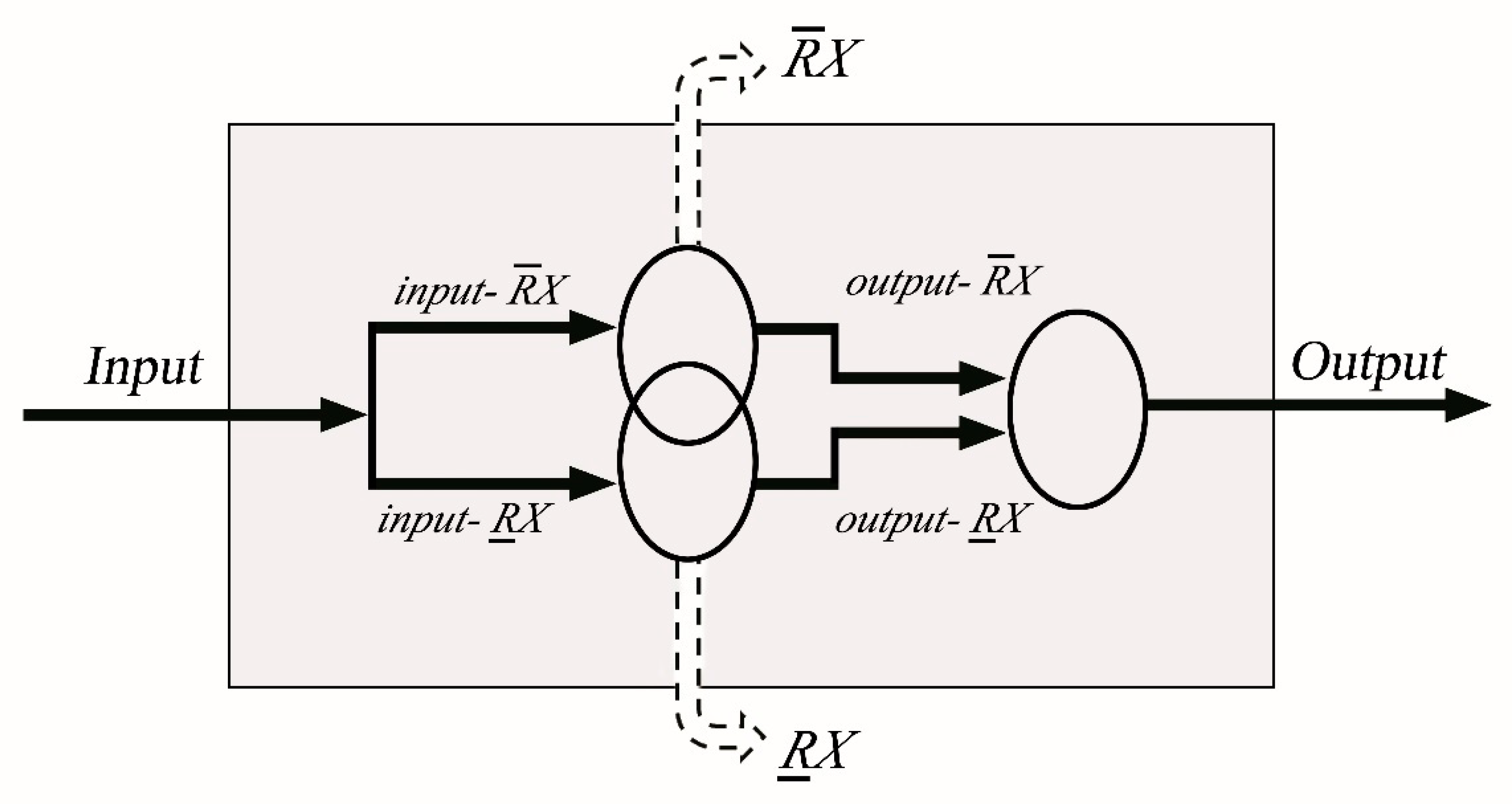


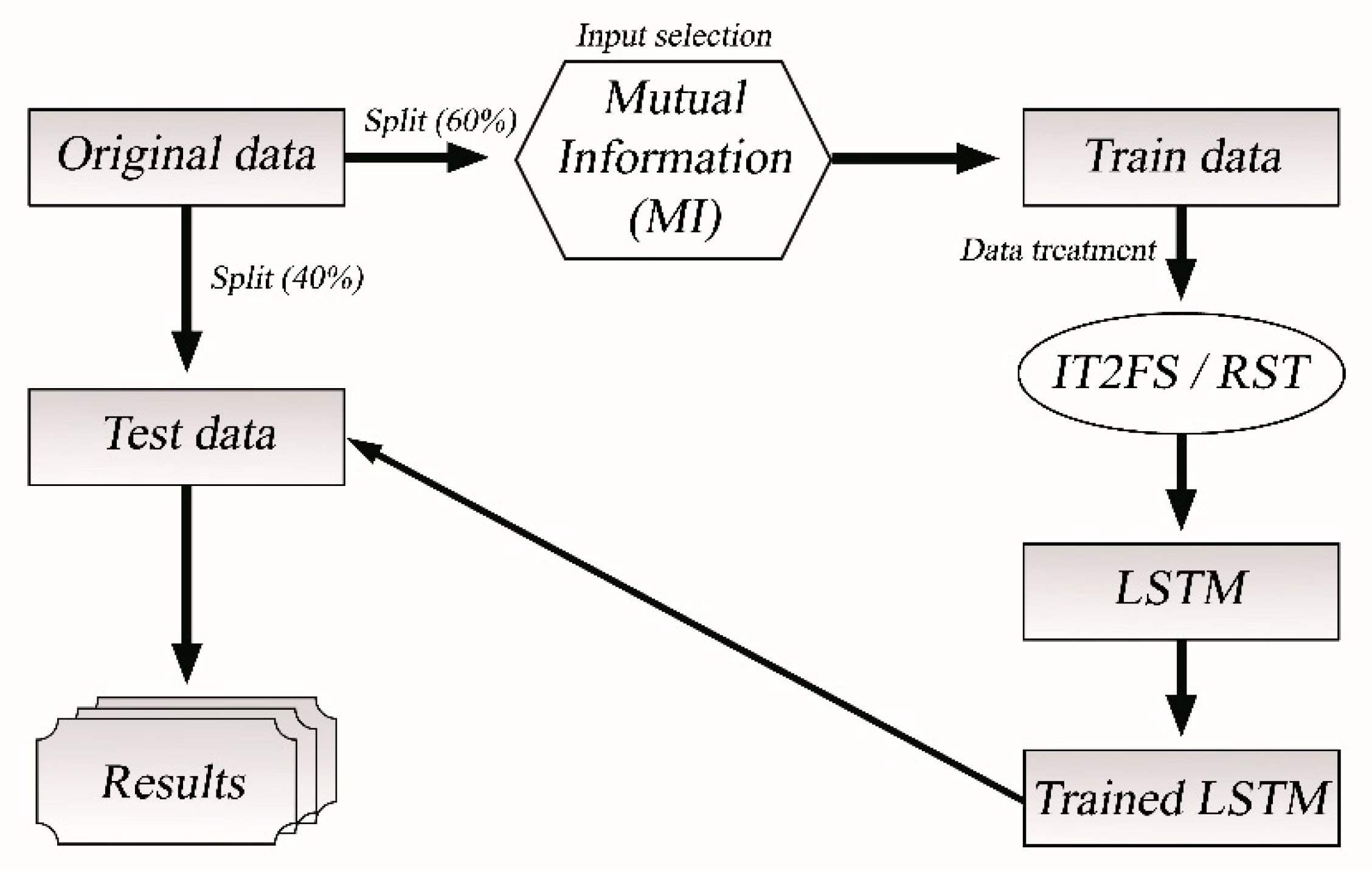

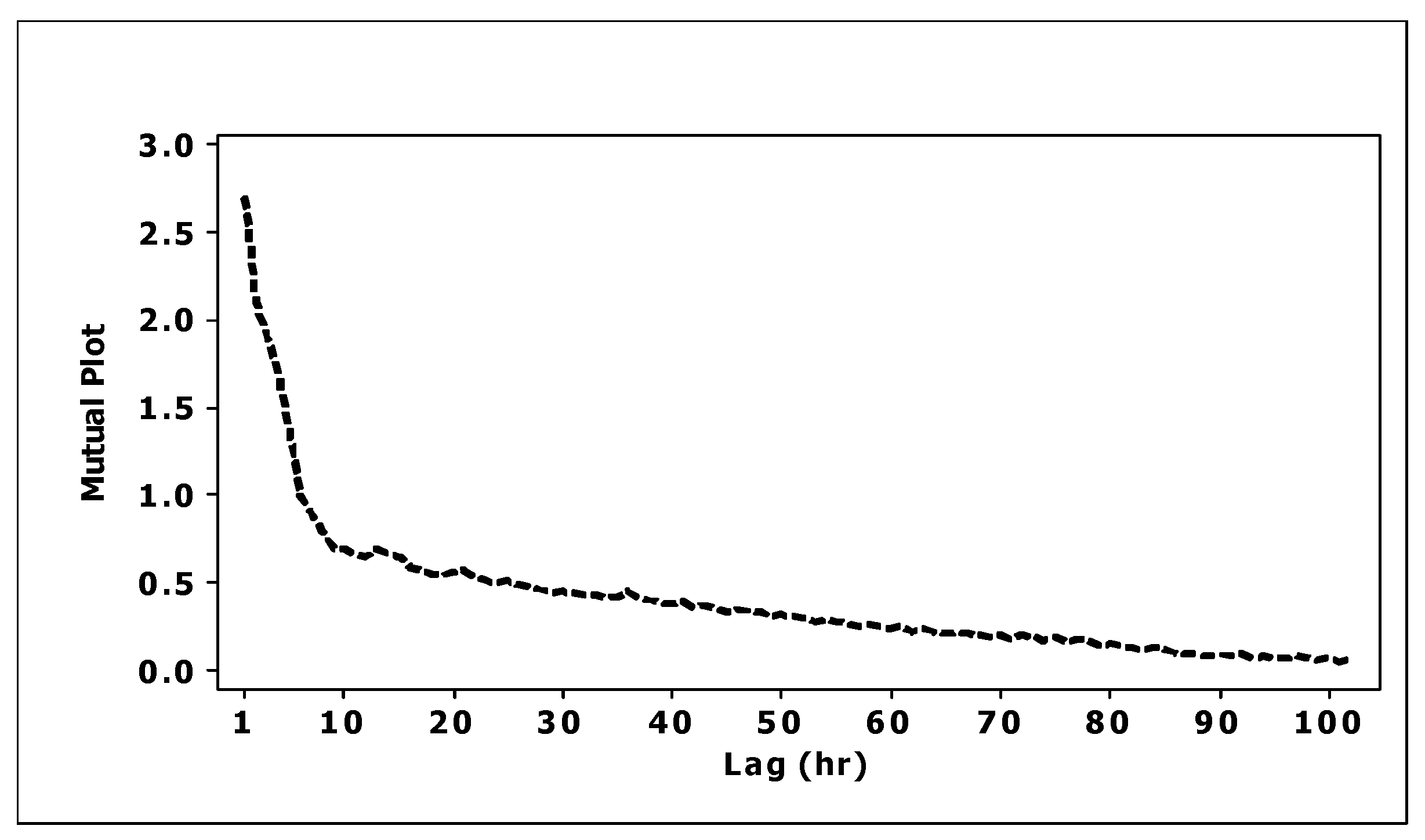
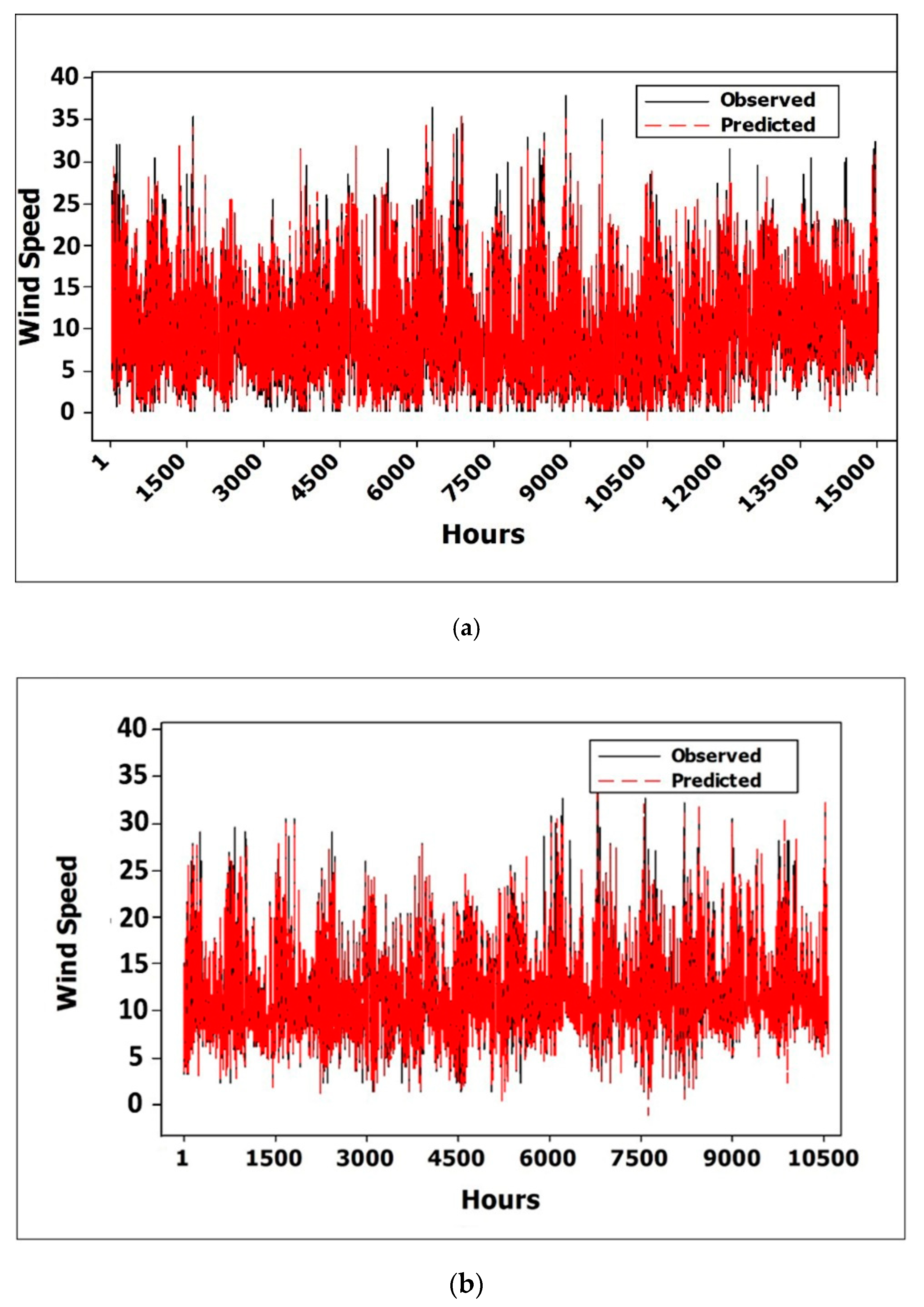
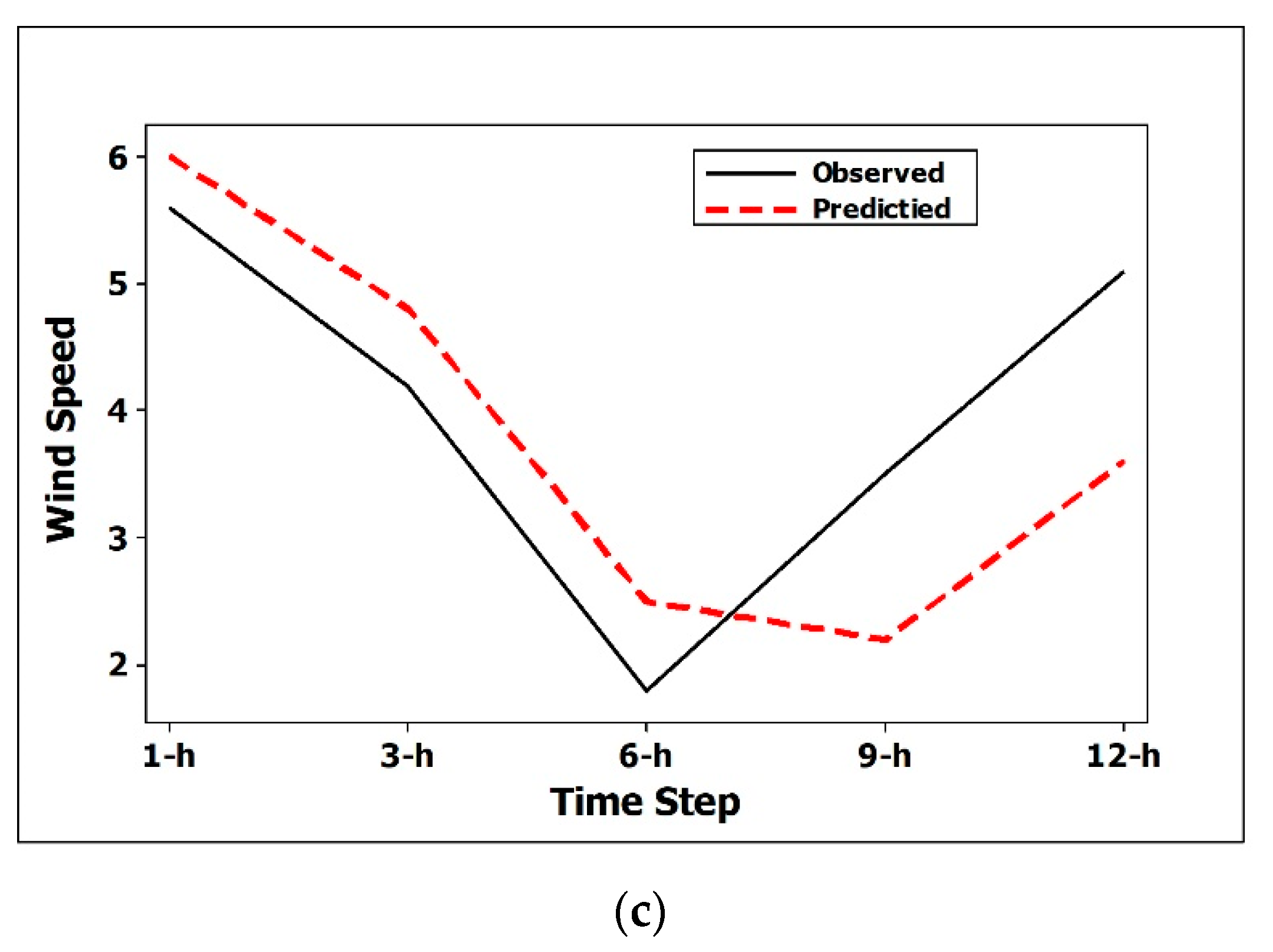
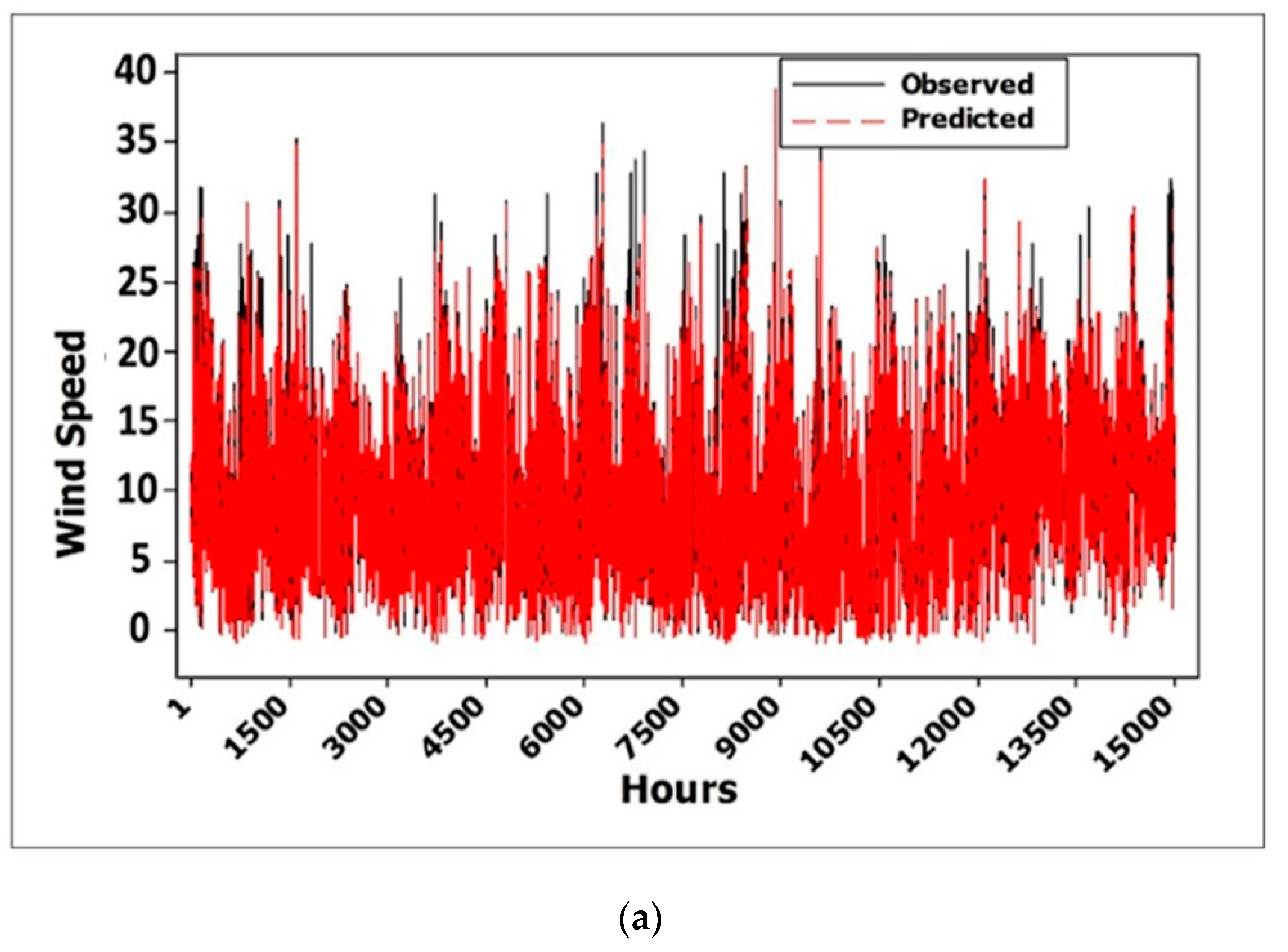
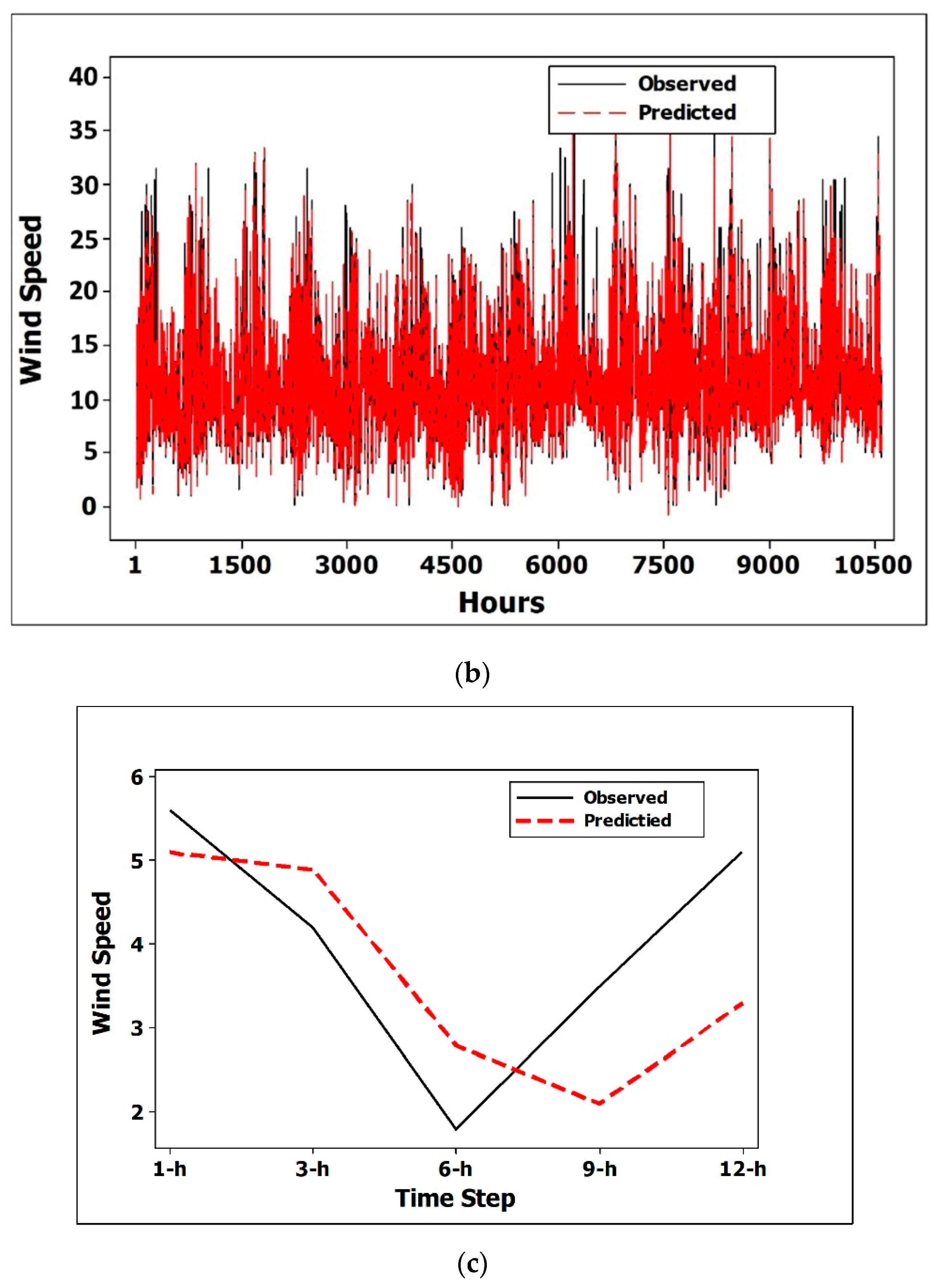

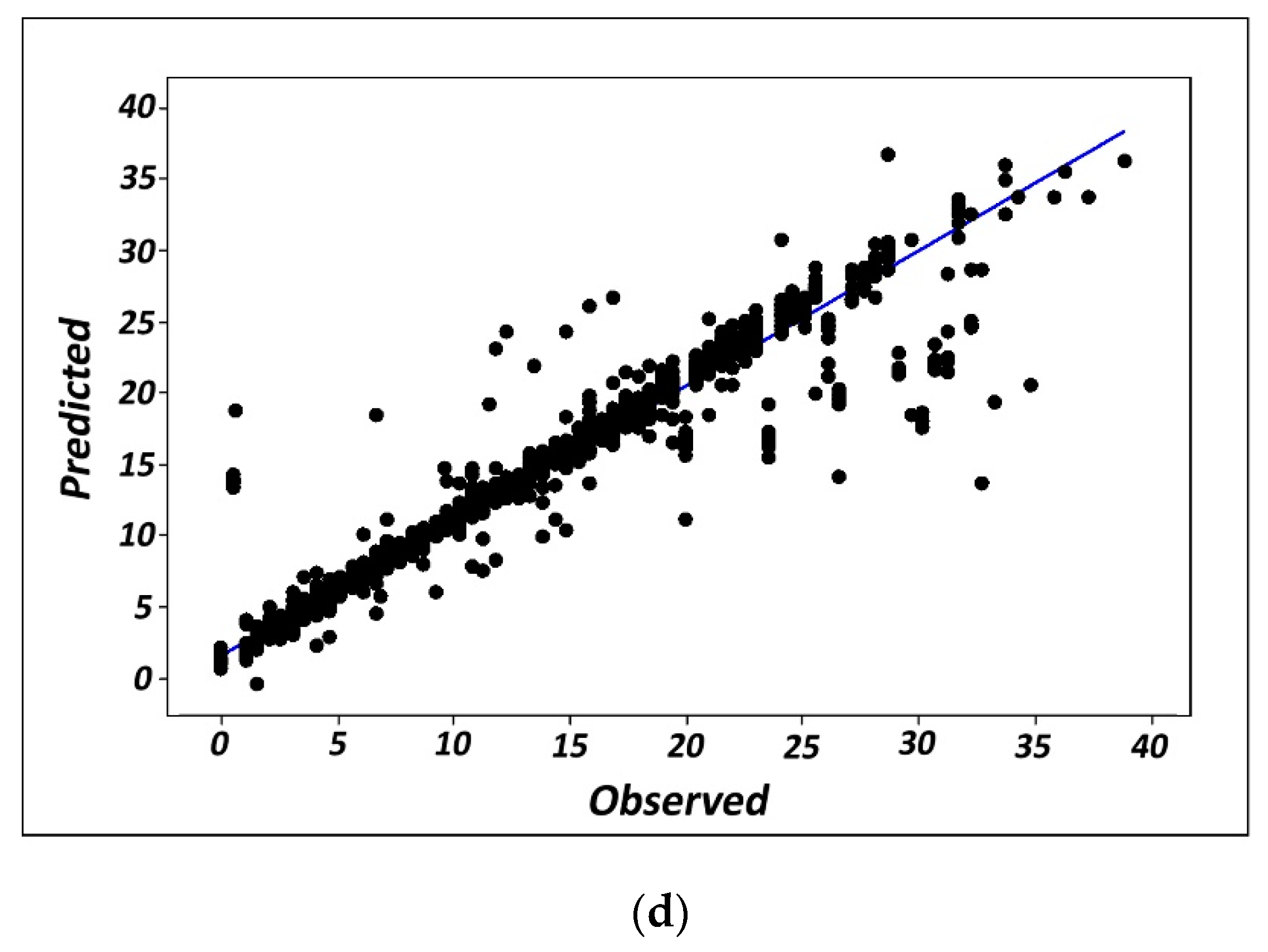
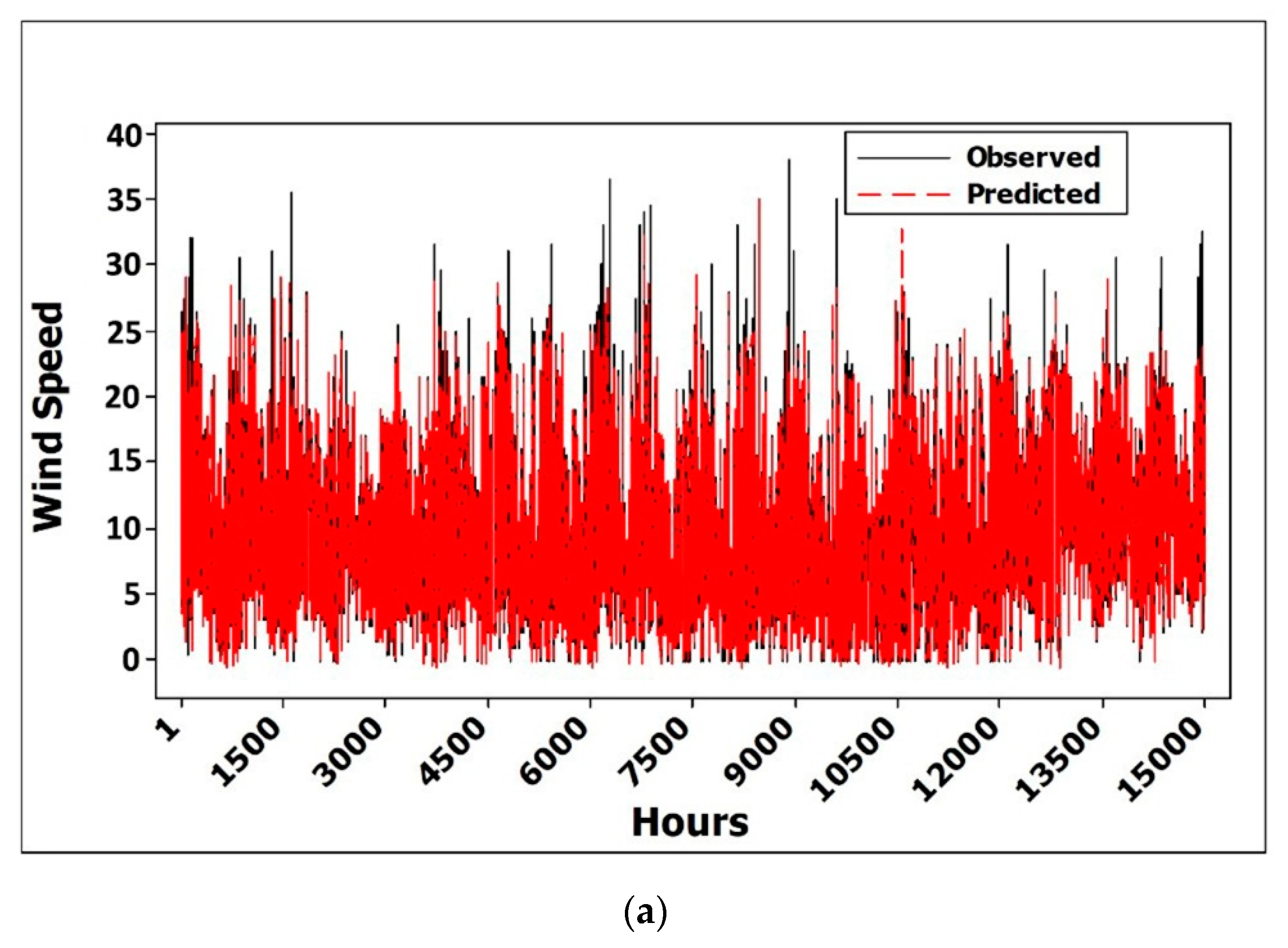
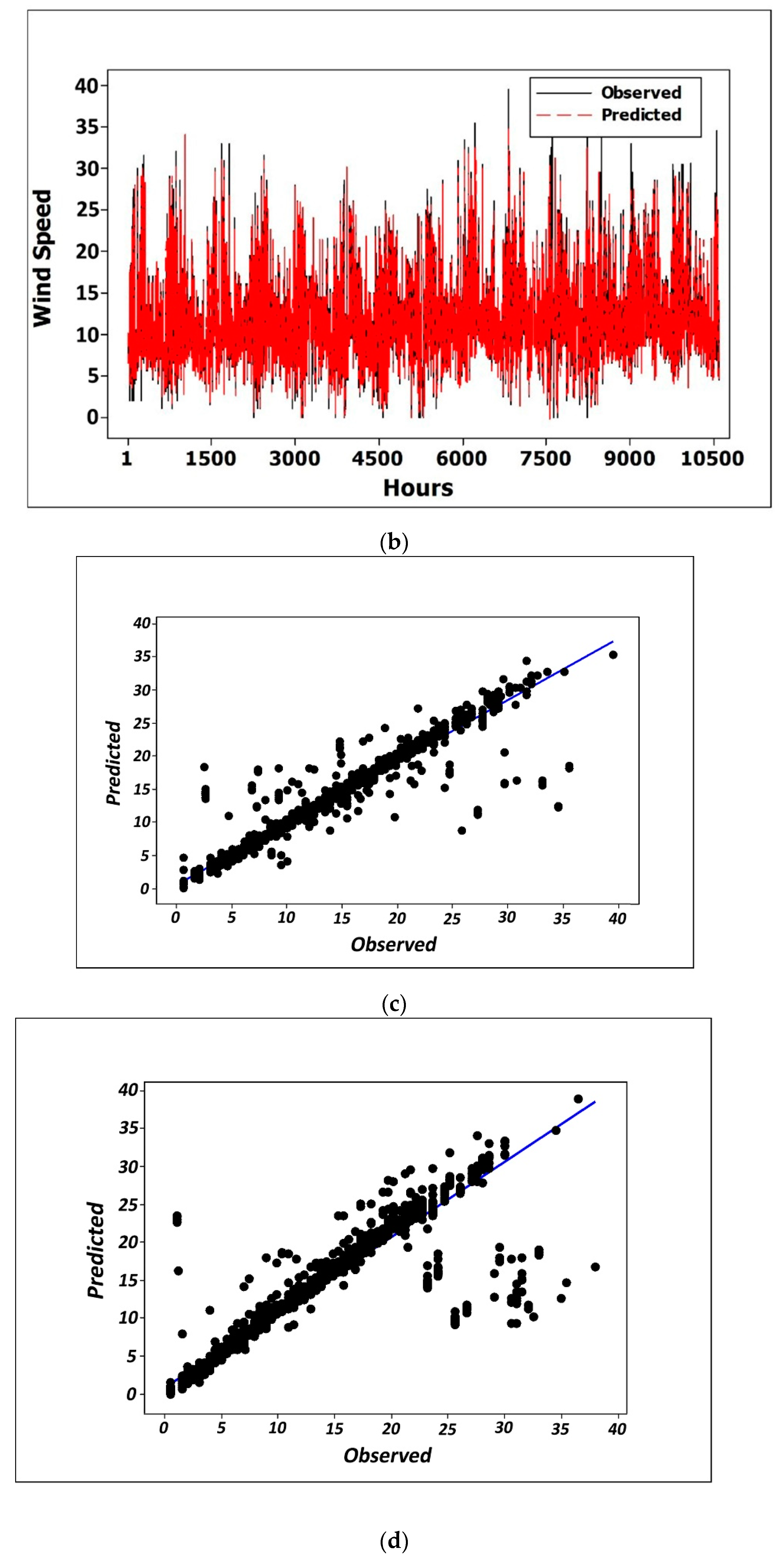
| Training | |||||
|---|---|---|---|---|---|
| Model | |||||
| Time Step | RST-LSTM | MLNN | IT2F-LSTM | LSTM | RNN |
| 1 h | 103 | 129 | 112 | 126 | 141 |
| 3 h | 109 | 138 | 119 | 132 | 155 |
| 6 h | 123 | 163 | 131 | 154 | 166 |
| 9 h | 145 | 174 | 152 | 167 | 179 |
| 12 h | 161 | 196 | 176 | 182 | 201 |
| Testing | |||||
| Method | |||||
| Time Step | RST-LSTM | MLNN | IT2F-LSTM | LSTM | RNN |
| 1 h | 130 | 155 | 136 | 149 | 161 |
| 3 h | 137 | 164 | 148 | 155 | 170 |
| 6 h | 169 | 187 | 174 | 183 | 189 |
| 9 h | 210 | 236 | 218 | 229 | 241 |
| 12 h | 245 | 272 | 251 | 263 | 277 |
| Training | |||||
|---|---|---|---|---|---|
| Model | |||||
| Time Step | RST-LSTM | MLNN | IT2F-LSTM | LSTM | RNN |
| 1 h | 0.065 | 0.087 | 0.074 | 0.089 | 0.099 |
| 3 h | 0.072 | 0.095 | 0.083 | 0.093 | 0.113 |
| 6 h | 0.085 | 0.113 | 0.091 | 0.112 | 0.119 |
| 9 h | 0.103 | 0.124 | 0.110 | 0.119 | 0.209 |
| 12 h | 0.116 | 0.226 | 0.205 | 0.213 | 0.230 |
| Testing | |||||
| Model | |||||
| Time Step | RST-LSTM | MLNN | IT2F-LSTM | LSTM | RNN |
| 1 h | 0.085 | 0.106 | 0.088 | 0.096 | 0.109 |
| 3 h | 0.099 | 0.119 | 0.105 | 0.112 | 0.132 |
| 6 h | 0.128 | 0.153 | 0.135 | 0.141 | 0.159 |
| 9 h | 0.149 | 0.224 | 0.152 | 0.201 | 0.252 |
| 12 h | 0.181 | 0.276 | 0.193 | 0.270 | 0.281 |
| Time Ahead | |||||
|---|---|---|---|---|---|
| Model | 1 h | 3 h | 6 h | 9 h | 12 h |
| RNN | 81-28-1 | 81-33-1 | 81-35-1 | 81-37-1 | 81-29-1 |
| LSTM | 81-14-1 | 81-13-1 | 81-14-1 | 81-16-1 | 81-13-1 |
| IT2F-LSTM | 81-15-1 | 81-16-1 | 81-15-1 | 81-18-1 | 81-21-1 |
| MLNN | 81-77-30-1 | 81-82-41-1 | 81-76-38-1 | 81-85-40-1 | 81-75-45-1 |
| RST-LSTM | 81-25-1 | 81-29-1 | 81-30-1 | 81-20-1 | 81-18-1 |
Publisher’s Note: MDPI stays neutral with regard to jurisdictional claims in published maps and institutional affiliations. |
© 2021 by the authors. Licensee MDPI, Basel, Switzerland. This article is an open access article distributed under the terms and conditions of the Creative Commons Attribution (CC BY) license (https://creativecommons.org/licenses/by/4.0/).
Share and Cite
Imani, M.; Fakour, H.; Lan, W.-H.; Kao, H.-C.; Lee, C.M.; Hsiao, Y.-S.; Kuo, C.-Y. Application of Rough and Fuzzy Set Theory for Prediction of Stochastic Wind Speed Data Using Long Short-Term Memory. Atmosphere 2021, 12, 924. https://doi.org/10.3390/atmos12070924
Imani M, Fakour H, Lan W-H, Kao H-C, Lee CM, Hsiao Y-S, Kuo C-Y. Application of Rough and Fuzzy Set Theory for Prediction of Stochastic Wind Speed Data Using Long Short-Term Memory. Atmosphere. 2021; 12(7):924. https://doi.org/10.3390/atmos12070924
Chicago/Turabian StyleImani, Moslem, Hoda Fakour, Wen-Hau Lan, Huan-Chin Kao, Chi Ming Lee, Yu-Shen Hsiao, and Chung-Yen Kuo. 2021. "Application of Rough and Fuzzy Set Theory for Prediction of Stochastic Wind Speed Data Using Long Short-Term Memory" Atmosphere 12, no. 7: 924. https://doi.org/10.3390/atmos12070924
APA StyleImani, M., Fakour, H., Lan, W.-H., Kao, H.-C., Lee, C. M., Hsiao, Y.-S., & Kuo, C.-Y. (2021). Application of Rough and Fuzzy Set Theory for Prediction of Stochastic Wind Speed Data Using Long Short-Term Memory. Atmosphere, 12(7), 924. https://doi.org/10.3390/atmos12070924







